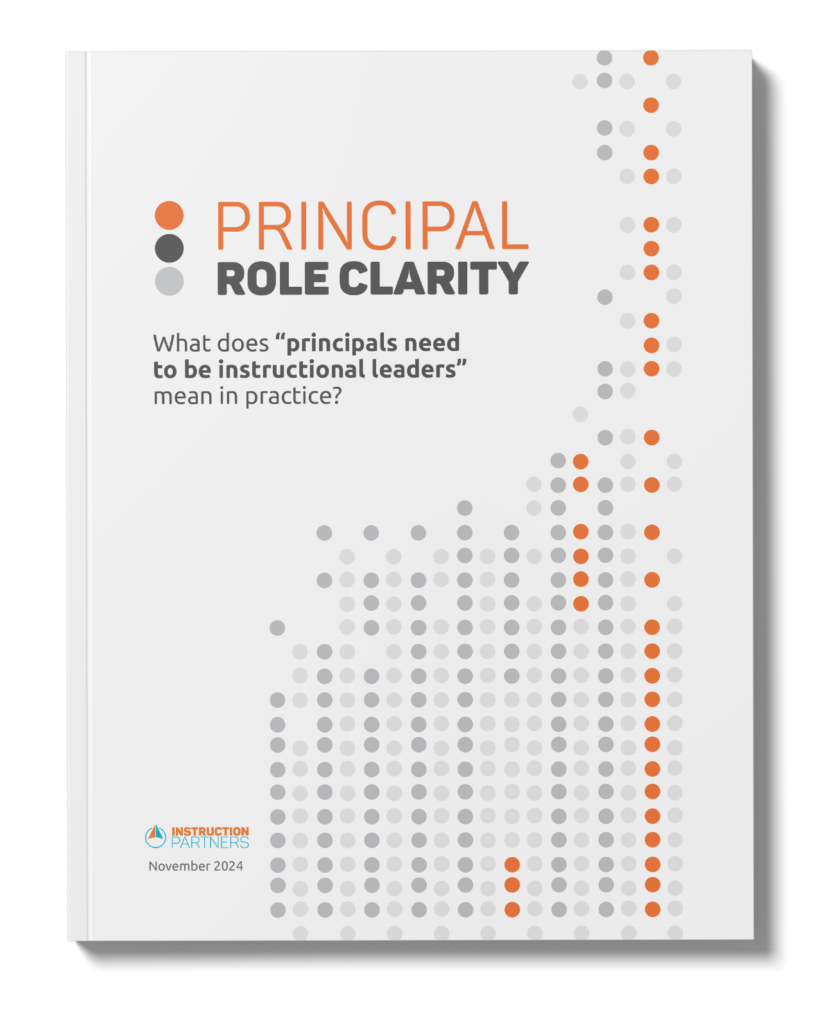
Q&A: How much do principals impact student outcomes?
Principals interact with every level of their school community—but how much impact do they actually have on student learning outcomes?
A 2021 report from the Wallace Foundation set out to answer that question. The answer? A lot.
The authors of How Principals Affect Students and Schools analyzed two decades of research and found that strong school leadership improves teacher retention, reduces absenteeism, and boosts student achievement—priorities at the top of every district’s list. Most notably, the report finds that when a below-average principal (i.e., at the 25th percentile of effectiveness) improves to an above-average principal (i.e., at the 75th percentile of effectiveness), the average student gains an additional three months of learning in math and reading.
The report describes four types of leadership practices that drive principal effectiveness:
- Engaging in instructionally focused interactions with teachers: Forms of engagement with teachers that center on instructional practice, such as teacher evaluation, instructional coaching, and the establishment of a data-driven, school-wide instructional program to facilitate such interactions.
- Building a productive school climate: Practices that encourage a school environment marked by trust, efficacy, teamwork, engagement with data, organizational learning, and continuous improvement.
- Facilitating productive collaboration and professional learning communities: Strategies that promote teachers working together authentically with systems of support to improve their practice and enhance student learning.
- Managing personnel and resources strategically: Processes around strategic staffing and allocation of time, budget, and other resources to meet school goals.
Q&A with Jason Grissom, co-author of How Principals Affect Students and Schools and professor of public policy and education at Vanderbilt University
Jason Grissom, co-author of the report and professor of public policy and education at Vanderbilt University, recently joined us for a webinar to answer educators’ questions about his research on the principal role. The questions and answers from the session are below—edited and abbreviated for clarity.
How involved are successful principals in school operations?
JG: School operations are really important, and I think sometimes get less attention than they should. There’s a bit of balance required for successful principals, because operations are clearly important, but principals have to be careful to not let too much of their time be devoted to operational issues that take them away from the core business of what a school does: teaching and learning. There are a lot of emerging strategies around delegating and harnessing others in the building. Leaders have to figure out, “What are the pieces of operations I have to take on myself and how much I can give over to others?” That is part of the fourth leadership behavior, “managing personnel and resources strategically.”
Can you share more about time allocation? For example, does the percent of time a principal spends on supporting instruction differentiate outcomes?
JG: When we think about managing resources strategically, we often don’t think enough about time—but it’s one of the most important resources we have.
We can think about time in two ways. There’s the school’s time—thinking about the school schedule. One important piece there is around teacher collaboration. If you want your grade-level teams to be able to collaborate, you have to create time structures during the school day to make that happen.
Then, there is the school leader’s time. There are time use studies that suggest that around 15–20% of the typical leader’s time is spent on instructional tasks—and a general sense that it should be quite a bit higher than that. But, studies on time demands also suggest that principals cannot easily reallocate their time, as much as they might like to. Time spent on instructional support tasks is partly a function of who else is involved in that work in a building.
The main point here is that thinking strategically about time and viewing time as a resource is one of the most important orientations that an effective leader can have.
The paper describes “facilitating collaboration and professional learning communities” as a separate leadership behavior from “engaging in instructionally-focused interactions with teachers.” Can you say more about the reasoning there? Are those collaborative spaces considered instructional interactions, or are they different?
JG: You can certainly think about the professional learning community as being another strategy for improving teacher instruction. We separated the two because there is a growing literature specifically on the importance of collaboration that really highlights how much kids benefit when adults in schools work together. The problems of teaching can be complex, but there’s a lot of expertise in the building that can be harnessed. For example, one way to think about “instructionally-focused interactions with teachers” is harnessing the expertise of the leadership team. Whereas, we think of professional learning communities more horizontally—that’s about harnessing the expertise and the insights of other teachers. Of course there is a role for leadership in facilitating collaboration for teachers, and creating the structures and space for teachers to be able to do that work.
Is there any research that speaks to how principal effectiveness changes over time in a school? Our district moves principals frequently. Would research suggest this is a bad or good thing?
JG: A few years ago, I published a study using data from Tennessee and Missouri that estimated the causal effects of principal turnover on outcomes. We found that turnover hurt student achievement in both states in math and reading, and it took the schools at least a year or two to recover. We also found principal turnover increases teacher turnover and saw some negative impacts on survey reports of school climate.
Additionally, evidence from supervisors’ ratings in Tennessee suggest that principals’ practices tend to improve as principals gain experience, which is a similar pattern to what we see for teachers. This pattern makes sense because a lot of learning in a complex role like teaching or school leadership is learning on-the-job.
These results suggest to me that moving principals among schools without a strong reason to do so may not be beneficial.
What are your personal feelings about the term “instructional leadership”?
JG: It’s not my favorite. “Instructional leadership” is a phrase that’s been used in the field for about 40 years. At the time that it became popular, the idea of instructional leadership was really about shifting the way that we think about school leadership from a primarily operational and administrative role to focusing more on instruction and learning. I do think that was a really valuable shift that needed to happen.
However, the problem now is that you can ask 100 people what “instructional leadership” means, and you’ll get 100 different definitions. I read a lot of research articles with the words “instructional leadership” in the opening sentence, and there’s never any follow-up clarification explaining, “This is what we mean by ‘instructional leadership’ in this study.”
When I talk to people in school districts, I find that there are general notions that principals should be involved in instruction—but what that actually looks like is often implicit and different from place to place. We’ve used the phrase for a long time without a lot of specificity about what we mean. If we’re going to move the work forward, we have to know what we’re collectively talking about. We need specificity.
You mentioned moving a principal from the bottom 25% up to the 75%. Does research suggest any key insights on what it takes to support principal growth?
JG: This is an important question and one I am working on right now in some ongoing research, so stay tuned! I’d say the best evidence we have is that the best way to support principal growth is to lean on what we already know is important from studies of adult learning: professionals learn complex roles when they get development opportunities that are ongoing, collaborative with their peers, and closely connected to their needs in their day-to-day work. In my conversations with lots of principals, the learning opportunities they get tend to fall pretty far from this standard.

Learn more
Principal Role Clarity: What does “principals need to be instructional leaders” mean in practice? explores the challenges of defining instructional leadership, particularly when it comes to principals’ role in supporting teaching and learning.


